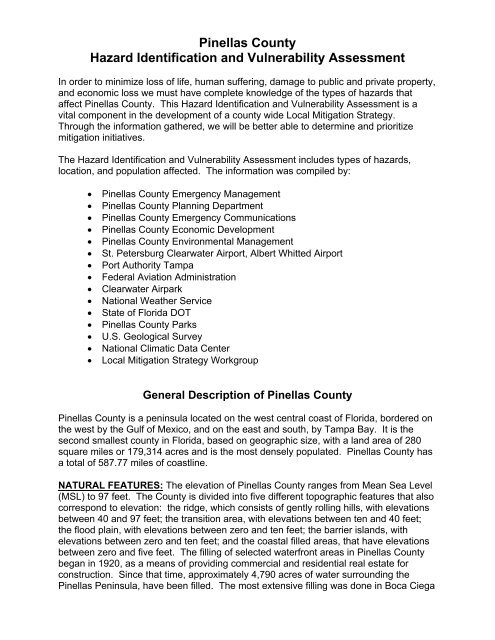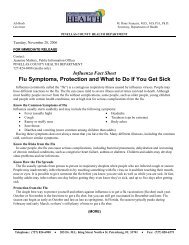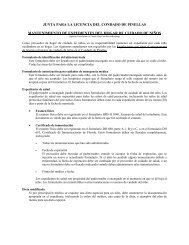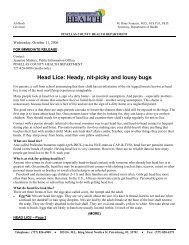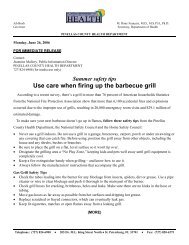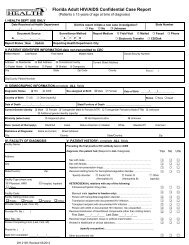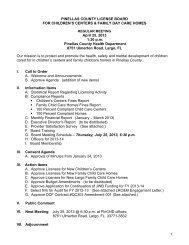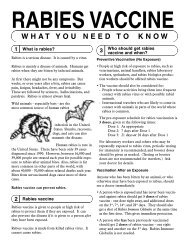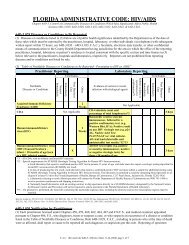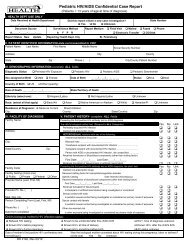Pinellas County Hazard Identification and Vulnerability Assessment
Pinellas County Hazard Identification and Vulnerability Assessment
Pinellas County Hazard Identification and Vulnerability Assessment
You also want an ePaper? Increase the reach of your titles
YUMPU automatically turns print PDFs into web optimized ePapers that Google loves.
<strong>Pinellas</strong> <strong>County</strong><br />
<strong>Hazard</strong> <strong>Identification</strong> <strong>and</strong> <strong>Vulnerability</strong> <strong>Assessment</strong><br />
In order to minimize loss of life, human suffering, damage to public <strong>and</strong> private property,<br />
<strong>and</strong> economic loss we must have complete knowledge of the types of hazards that<br />
affect <strong>Pinellas</strong> <strong>County</strong>. This <strong>Hazard</strong> <strong>Identification</strong> <strong>and</strong> <strong>Vulnerability</strong> <strong>Assessment</strong> is a<br />
vital component in the development of a county wide Local Mitigation Strategy.<br />
Through the information gathered, we will be better able to determine <strong>and</strong> prioritize<br />
mitigation initiatives.<br />
The <strong>Hazard</strong> <strong>Identification</strong> <strong>and</strong> <strong>Vulnerability</strong> <strong>Assessment</strong> includes types of hazards,<br />
location, <strong>and</strong> population affected. The information was compiled by:<br />
• <strong>Pinellas</strong> <strong>County</strong> Emergency Management<br />
• <strong>Pinellas</strong> <strong>County</strong> Planning Department<br />
• <strong>Pinellas</strong> <strong>County</strong> Emergency Communications<br />
• <strong>Pinellas</strong> <strong>County</strong> Economic Development<br />
• <strong>Pinellas</strong> <strong>County</strong> Environmental Management<br />
• St. Petersburg Clearwater Airport, Albert Whitted Airport<br />
• Port Authority Tampa<br />
• Federal Aviation Administration<br />
• Clearwater Airpark<br />
• National Weather Service<br />
• State of Florida DOT<br />
• <strong>Pinellas</strong> <strong>County</strong> Parks<br />
• U.S. Geological Survey<br />
• National Climatic Data Center<br />
• Local Mitigation Strategy Workgroup<br />
General Description of <strong>Pinellas</strong> <strong>County</strong><br />
<strong>Pinellas</strong> <strong>County</strong> is a peninsula located on the west central coast of Florida, bordered on<br />
the west by the Gulf of Mexico, <strong>and</strong> on the east <strong>and</strong> south, by Tampa Bay. It is the<br />
second smallest county in Florida, based on geographic size, with a l<strong>and</strong> area of 280<br />
square miles or 179,314 acres <strong>and</strong> is the most densely populated. <strong>Pinellas</strong> <strong>County</strong> has<br />
a total of 587.77 miles of coastline.<br />
NATURAL FEATURES: The elevation of <strong>Pinellas</strong> <strong>County</strong> ranges from Mean Sea Level<br />
(MSL) to 97 feet. The <strong>County</strong> is divided into five different topographic features that also<br />
correspond to elevation: the ridge, which consists of gently rolling hills, with elevations<br />
between 40 <strong>and</strong> 97 feet; the transition area, with elevations between ten <strong>and</strong> 40 feet;<br />
the flood plain, with elevations between zero <strong>and</strong> ten feet; the barrier isl<strong>and</strong>s, with<br />
elevations between zero <strong>and</strong> ten feet; <strong>and</strong> the coastal filled areas, that have elevations<br />
between zero <strong>and</strong> five feet. The filling of selected waterfront areas in <strong>Pinellas</strong> <strong>County</strong><br />
began in 1920, as a means of providing commercial <strong>and</strong> residential real estate for<br />
construction. Since that time, approximately 4,790 acres of water surrounding the<br />
<strong>Pinellas</strong> Peninsula, have been filled. The most extensive filling was done in Boca Ciega
Bay, where 25% of the Bay, or approximately 2,506 acres were filled. This practice has<br />
been discontinued.<br />
RIVERS, CREEKS AND LAKES: <strong>Pinellas</strong> <strong>County</strong> has only one river, the Anclote. It<br />
exits into the Gulf of Mexico <strong>and</strong> is located in the extreme northern portion of the<br />
<strong>County</strong>, in the Tarpon Springs vicinity. There are numerous creeks <strong>and</strong> drainage<br />
channels in the county.<br />
Lake Tarpon is the largest lake in the <strong>County</strong>, covering 2,534 acres. It is fed by<br />
groundwater <strong>and</strong> at the surface by Brooker Creek. Until 1967, the lake was connected<br />
hydrologically to Spring Bayou (eventually flowing into the Anclote River) but was<br />
subsequently damned off by the US Army Corps Of Engineers in order to control<br />
saltwater intrusion into Lake Tarpon. A controlled height canal is an outfall for the lake<br />
into Tampa Bay near the City of Safety Harbor <strong>and</strong> is used to maintain the water level at<br />
approximately 3.1 feet above mean sea level. Lake Seminole is 980 acres in surface<br />
area <strong>and</strong> was formerly an estuary at the end of Long Bayou. Only about five feet deep,<br />
many outfalls from the western shoreline empty into the lake. Lake Maggiore is 380<br />
acres in size <strong>and</strong> ten feet deep. Other large lakes in the <strong>County</strong> include: Salt Lake 220<br />
acres; Lake Del Oro 75 acres; Alligator Lake 77 acres; Lake St. George <strong>and</strong> Lake<br />
Chautaugua each about 50 acres.<br />
ISLANDS: There are a series of barrier isl<strong>and</strong>s in close proximity to the mainl<strong>and</strong> coast.<br />
These isl<strong>and</strong>s extend about 34 miles along the western coastline of the <strong>County</strong>. With<br />
the exception of Caladesi Isl<strong>and</strong> <strong>and</strong> Anclote Key, all barrier isl<strong>and</strong>s are connected to<br />
the mainl<strong>and</strong> by a series of 14 causeways <strong>and</strong> bridges. The barrier isl<strong>and</strong>s are densely<br />
populated <strong>and</strong> completely built out. Their population consists of single family houses,<br />
hotels/motels, condominiums <strong>and</strong> mobile home parks.<br />
CLIMATE: The climate in <strong>Pinellas</strong> <strong>County</strong> is subtropical marine, characterized by long,<br />
humid summers <strong>and</strong> mild winters. Rainfall is abundant, especially during the summer<br />
months.<br />
The annual average rainfall is 51.9 inches, mostly occurring during June through<br />
September. The driest months of the year are April <strong>and</strong> November. Snowfall in<br />
<strong>Pinellas</strong> <strong>County</strong> is rare. The maximum recorded monthly accumulation was two inches<br />
in January, 1977.<br />
The average annual temperature is 74.1 degrees Fahrenheit. The average high is 81.7<br />
Fahrenheit <strong>and</strong> the average low is 60.6. In the winter months, the normal daily<br />
fluctuation in temperatures is from the low 50s to the low 70s. In the summer months,<br />
the temperatures range from the low 70s to the high 90s.<br />
The number of freezes recorded, at Tampa International Airport, is an average of 3.3<br />
days at 32 degrees Fahrenheit or below per year. Due to <strong>Pinellas</strong> <strong>County</strong>’s exposure to<br />
shoreline, our average number of freezes may be less than those recorded at Tampa<br />
International Airport.<br />
<strong>Pinellas</strong> <strong>County</strong> has a very active thunderstorm season during the summer. There is an<br />
average of 85.1 thunderstorms a year. Most occur during the months of June through<br />
September. The hurricane season extends from June 1 through November 30.
POPULATION: <strong>Pinellas</strong> <strong>County</strong> has the fifth largest population in Florida, with an<br />
estimated 927,438 permanent residents, 42,890 seasonal residents, <strong>and</strong> 89,166 tourists<br />
for a total of 1,059,495 in the year 2000. The current population density is 3,312<br />
persons per square mile. A large percentage of residents live in coastal communities.<br />
It is estimated, in the year 2030, the total county population will be 1,146,934.<br />
Permanent Population Estimates<br />
Municipality 1997<br />
Belleair 4,153<br />
Belleair Beach 2,196<br />
Belleair Bluffs 2,096<br />
Belleair Shore 60<br />
Clearwater 103,521<br />
Dunedin 35,440<br />
Gulfport 11,961<br />
Indian Rocks Beach 4,242<br />
Indian Shores 1,489<br />
Kenneth City 4,454<br />
Largo 67,906<br />
Madeira Beach 4,220<br />
North Redington Beach 1,161<br />
Oldsmar 9,666<br />
<strong>Pinellas</strong> Park 44,736<br />
Redington Beach 1,575<br />
Redington Shores 2,436<br />
Safety Harbor 17,054<br />
St. Petersburg 241,810<br />
St. Pete Beach 9,801<br />
Seminole 9,325<br />
South Pasadena 5,971<br />
Tarpon Springs 19,971<br />
Treasure Isl<strong>and</strong> 7,378<br />
Unincorporated 280,848<br />
Population Living in Hurricane Evacuation Levels<br />
An estimated 676,250 residents will have to evacuate for a worst case hurricane<br />
scenario. The figures below depict the cumulative numbers of people who would have<br />
to evacuate based on the severity or category of the hurricane.<br />
Level A Level B Level C Level D Level E<br />
Cat 1 Cat 2 Cat 3 Cat 4 Cat 5<br />
392,010 482,190 581,000 647,190 676,250<br />
Economic Indicators
1997-1998 Annual Average Unemployment Rate was 3.5%<br />
Income <strong>County</strong> Ranking in State:<br />
#4 Total personal income ($23.7 billion in 1996)<br />
#7 Total earned income ($12.9 billion in 1996)<br />
#8 Per capita income ($27,311 in 1996)<br />
<strong>Pinellas</strong> <strong>County</strong> ranks first in the State in total retail sales, food stores, general<br />
merch<strong>and</strong>ise stores, automobile dealerships, <strong>and</strong> building material/hardware<br />
establishments.<br />
The <strong>Pinellas</strong> <strong>County</strong> School district is the 7th largest school district in Florida.<br />
Tourism was up approximately 3% in 1997 from 1996. Over 4.3 million people visited<br />
<strong>Pinellas</strong> <strong>County</strong> in 1997, spending an estimated $2.3 billion.<br />
HOUSING: There are an estimated 500,000 housing units in <strong>Pinellas</strong> <strong>County</strong>. There<br />
are 368 mobile home parks with 56,305 units. 73,955 Condominiums, <strong>and</strong> 78,665<br />
Apartments.<br />
TRANSPORTATION: <strong>Pinellas</strong> <strong>County</strong> is serviced by five major highways, I-275, US<br />
Highway 19, US 19A, US 92, <strong>and</strong> Highway 60. Other major transportation routes are as<br />
follows: Tarpon Avenue/SR582, Tampa Road/752-SR584, Curlew Road/SR586, East<br />
Bay/SR686, Ulmerton Road/SR688, Park Boulevard/G<strong>and</strong>y Boulevard, CR611, SR580,<br />
SR 693 <strong>and</strong> Gulf Boulevard/SR699.<br />
Airports: There are three airports located in <strong>Pinellas</strong> <strong>County</strong>, the St. Petersburg-<br />
Clearwater International Airport which houses the largest Coast Guard Air Station in<br />
the country, Albert Whitted Municipal Airport, <strong>and</strong> the Clearwater Airpark.<br />
Additionally, in close proximity, in Hillsborough <strong>County</strong>, are Tampa International<br />
Airport <strong>and</strong> MacDill Air Force Base.<br />
Bus: There are two bus lines operating in <strong>Pinellas</strong> <strong>County</strong>. One bus line, the<br />
<strong>Pinellas</strong> Suncoast Transit Authority with a fleet of 143 buses, provides intra-county<br />
public transportation. The other bus line, Greyhound, provides inter-state service.<br />
Additionally, the <strong>Pinellas</strong> <strong>County</strong> School Board operates a fleet of 573 school buses<br />
for the movement of students.<br />
Railroad: CSX operates a single line freight rail service through mostly industrial<br />
areas in <strong>Pinellas</strong> <strong>County</strong>. Most of the railway in <strong>Pinellas</strong> <strong>County</strong> has been<br />
converted into the <strong>Pinellas</strong> Trail, a recreational thoroughfare that traverses the<br />
county.<br />
Waterways: <strong>Pinellas</strong> <strong>County</strong> has two ports, Port of St. Petersburg <strong>and</strong> Port Tarpon<br />
for shallow draft ships. Deep draft ships must use Port Tampa in Hillsborough<br />
<strong>County</strong> or Port Manatee in Manatee <strong>County</strong>. In 1998, Port Tampa recorded 4,077<br />
operations. The majority shipped fertilizer <strong>and</strong> phosphates. The total number of<br />
barges in Tampa’s operations is 1,251 <strong>and</strong> the total number of vessels <strong>and</strong> tugs are<br />
1,172. There are several smaller ports <strong>and</strong> terminals throughout Tampa Bay.
The following are significant historical waterway accidents: 1980 Black Thorn <strong>and</strong><br />
Capricorn both sunk, 1980 Summit Venture <strong>and</strong> the Skyway Bridge with major<br />
fatalities, <strong>and</strong> 1993 three vessels collided which caused a significant oil spill. There<br />
have been several groundings with no pollution.<br />
SPECIAL FACILITIES/POPULATIONS:<br />
There are 20 hospitals with one in evacuation Level A, one in evacuation Level B, one in<br />
evacuation Level C, one in evacuation Level D, <strong>and</strong> three in evacuation Level E.<br />
There are 324 Assisted Living Facilities. Thirty five are in an evacuation Level A, 28<br />
are in evacuation Level B, 28 are in evacuation Level C, 35 are in evacuation Level D,<br />
<strong>and</strong> 12 are in evacuation Level E.<br />
There are 84 Nursing Homes. Seven are in evacuation Level A, nine are in evacuation<br />
Level B, ten evacuation Level C, nine are in evacuation Level D, <strong>and</strong> two are in<br />
evacuation Level E.<br />
The following is an estimated number of patients who would require evacuation for the<br />
various levels/categories of hurricanes:<br />
LEVEL A B C D E<br />
Hospital 0 260 300 774 1,119<br />
Nursing Home 389 1,317 1,993 3,354 3,991<br />
Total 389 1,577 2,293 4,128 5,110<br />
There are 15 Ambulatory Surgical Centers. Two are in evacuation Level A, four are in<br />
evacuation Level B, <strong>and</strong> one in evacuation Level D.<br />
There are approximately 30,000 people receiving home health care <strong>and</strong> 1,200 receiving<br />
Hospice Care in <strong>Pinellas</strong> <strong>County</strong>. To date, we have 1,600 registered in the Special<br />
Needs Program meaning they have no means of transportation in the event of a<br />
disaster.<br />
Natural <strong>Hazard</strong>s Affecting <strong>Pinellas</strong> <strong>County</strong><br />
Drought<br />
History: Drought occurs every few years even after periods of heavy rain. They can<br />
become severe if several months pass without significant precipitation. During such<br />
droughts, restrictions have been placed on water usage. As a result, alternative water<br />
sources, such as desalination plants, are being studied.<br />
Probability: Based on historical trends, the frequency of drought in Florida is every five<br />
to ten years. Fortunately, the geographic location of Florida places it at far less risk for<br />
drought than the western states, because Florida remains humid, even with less than<br />
average rainfall. Thus, the occurrence of drought is considered to be low.
<strong>Vulnerability</strong>: <strong>Pinellas</strong> <strong>County</strong> does not have much open wildl<strong>and</strong>. That which does<br />
exist is located mostly in the northern areas of the <strong>County</strong>; Safety Harbor, East Lake,<br />
<strong>and</strong> Oldsmar. When such wildl<strong>and</strong> becomes parched, it becomes more susceptible to<br />
wildfires.<br />
<strong>Pinellas</strong> <strong>County</strong> is surrounded by water, thus at first glance one might think that the area<br />
could never suffer from drought. Unfortunately, the water is saltwater <strong>and</strong> is not<br />
currently available for human consumption or daily uses. When considering how<br />
densely populated the <strong>County</strong> has become, <strong>and</strong> the high dem<strong>and</strong>s placed on the water<br />
supply daily, the area can be moderately vulnerable to drought.<br />
Maximum Threat: A prolonged drought combined with sunny <strong>and</strong> warm conditions<br />
resulting in very low water levels <strong>and</strong> the need for water rationing.<br />
Earthquake<br />
The probability of an earthquake is very low, however the impact would be major<br />
throughout the county.<br />
Flooding - Coastal<br />
History: <strong>Pinellas</strong> <strong>County</strong> is a peninsula with a total of 587.77 miles of coastline, which<br />
makes it extremely vulnerable to coastal flooding. The <strong>County</strong> has experienced a<br />
number of damaging coastal floods caused by wind-driven water associated with an<br />
astronomical high tide.<br />
June 1972: Hurricane Agnes, although well out in the Gulf of Mexico, caused a winddriven<br />
high tide of 5.6 feet, that struck <strong>Pinellas</strong> <strong>County</strong> on June 19, 1972. It caused an<br />
estimated 12 million dollars in damages to public <strong>and</strong> private property.<br />
June 1982: On June 18, 1982, <strong>Pinellas</strong> <strong>County</strong> was struck by severe coastal flooding<br />
from the “no-name” storm. The highest recorded winds from the storm were 49 mph<br />
<strong>and</strong> rainfall amounts were between four to six inches. The estimated public <strong>and</strong> private<br />
property damage from the “no-name” storm were over 16 million dollars.<br />
March 1993: The “Storm of the Century” was a very powerful winter storm which<br />
generated Category 1 “hurricane - like” storm surges. A 7.7 feet above normal reading<br />
was taken on Clearwater Beach.<br />
Probability: Serious coastal flooding has occurred in <strong>Pinellas</strong> <strong>County</strong> three times in the<br />
last 26 years. Statistically, the frequency of occurrence of tidal water elevation, based<br />
on a study conducted by the Coastal <strong>and</strong> Oceanographic Engineering Laboratory is<br />
shown below:<br />
Water Level Elevation Above<br />
Frequency:<br />
MSL:<br />
3 feet or higher Once in 3 - 5 years
4 feet or higher Once in 20 years<br />
5 feet of higher Once in 25 - 30 years<br />
6 feet or higher Once in 30 - 50 years<br />
7 feet or higher Once in 60 - 90 years<br />
8 feet or higher Once in 90 - 100 years<br />
Statistics indicate a high tide above five feet only once in 25 to 30 years, however, there<br />
have been three incidents of coastal flooding in the last 26 years, caused by a high tide<br />
of between five <strong>and</strong> six feet. This indicates that <strong>Pinellas</strong> <strong>County</strong> might expect severe<br />
coastal flooding once every 8.7 years. The probability of major coastal flooding is<br />
considered to be high.<br />
<strong>Vulnerability</strong>: Based on historical information, <strong>Pinellas</strong> <strong>County</strong> remains highly<br />
vulnerable to wind blown high tide on the barrier isl<strong>and</strong>s <strong>and</strong> in other low lying areas<br />
along the coastline. The risk to both population <strong>and</strong> property continues to grow with<br />
development of vulnerable areas.<br />
Maximum Threat: The maximum threat to <strong>Pinellas</strong> <strong>County</strong> is a storm generation gale<br />
force wind from the west or southwest, striking the coastline during an astronomical high<br />
tide. This would place over 60,000 persons at risk, as well as 30,000 dwelling units.<br />
Estimated damages would be between 30 <strong>and</strong> 40 million dollars.<br />
Flooding - Rainfall<br />
History: Fresh water flooding problems due to rainfall are evident in many sections of<br />
<strong>Pinellas</strong> <strong>County</strong>. Rapid development during the past twenty years has aggravated this<br />
problem, especially in areas of poor drainage. Prolonged periods of rainfall have shown<br />
increased potential for causing damage to property <strong>and</strong> evacuation of residents due to<br />
flooding. This problem becomes more severe if the heavy rainfall occurs at the same<br />
time as the astronomical high tide, which prevents much of the rainwater from flowing<br />
through the drainage system into the Gulf of Mexico or Tampa Bay. <strong>Pinellas</strong> <strong>County</strong><br />
has experienced a number of damaging floods during the past twenty years. The most<br />
significant are:<br />
June 1974: During the period of June 22 through June 30, 1974, <strong>Pinellas</strong> <strong>County</strong><br />
received between 20 <strong>and</strong> 30 inches of rain. Damage to public <strong>and</strong> private property<br />
totaled more than twenty million dollars.<br />
May 1979: <strong>Pinellas</strong> <strong>County</strong> was hit by torrential rains during the period of May 7-8,<br />
1979. Portions of the <strong>County</strong> received between ten <strong>and</strong> 18 inches of rainfall during a<br />
12-hour period. The City of <strong>Pinellas</strong> Park was particularly hard-hit. In several areas of<br />
the <strong>County</strong>, the rainfall surpassed the 100-year level. The amount of damage to<br />
<strong>Pinellas</strong> <strong>County</strong> resulted in Presidential Disaster Declaration 586.<br />
September 1979: During the months of August <strong>and</strong> September 1979, Central Florida,<br />
including <strong>Pinellas</strong> <strong>County</strong>, experienced the most significant period of rainfall in over<br />
three decades. In some areas, the two month rainfall totaled more than 40 inches.<br />
September 1988: After a week of light to moderate rains, flooding began to occur<br />
county-wide. Areas of <strong>Pinellas</strong> Park, Clearwater <strong>and</strong> Dunedin were hardest hit. 13.25
inches of rain were recorded.<br />
Probability: Serious flooding has occurred four times in the past 20 years, with one<br />
incident, May 8, 1979, causing a Presidential Disaster Declaration. Although the<br />
drainage system has been greatly improved as a result of the past flooding, there is<br />
potential for the situation to occur again during periods of higher than normal rainfall.<br />
Based on past history, <strong>Pinellas</strong> <strong>County</strong> can expect heavy rainfall to cause flooding once<br />
every 3.3 years. Therefore, the probability for major flooding is considered to be high<br />
during any given year.<br />
<strong>Vulnerability</strong>: With the high probability of fresh water flooding <strong>and</strong> the continued<br />
development throughout <strong>Pinellas</strong> <strong>County</strong>, both on low ground <strong>and</strong> high ground, the<br />
vulnerability of population <strong>and</strong> property must also be considered as high. Historically,<br />
the older sections of <strong>Pinellas</strong> Park, Dunedin, <strong>and</strong> Clearwater have shown a vulnerability<br />
to fresh water type flooding.<br />
Maximum Threat: The maximum threat to <strong>Pinellas</strong> <strong>County</strong> would be a May 8, 1979 type<br />
of storm, which deposited almost 18 inches of rainfall in the lower central part of the<br />
<strong>County</strong> during a 12-hour period. The situation would become more critical if the storm<br />
was preceded by a long period of rainfall over a one to two month period, or if<br />
accompanied by a high tide situation. Although drainage has been improved, it is<br />
estimated that homes would still be at risk for potential flooding in the <strong>Pinellas</strong> Park <strong>and</strong><br />
North St. Petersburg areas.<br />
Freezes<br />
History: <strong>Pinellas</strong> <strong>County</strong> is subject to frost <strong>and</strong>/or freezing temperatures from November<br />
through March each year. Since 1962, there have been 12 freezes that have affected<br />
<strong>Pinellas</strong> <strong>County</strong>. The month <strong>and</strong> year are shown below:<br />
December 1962 January 1981 December 1985<br />
November 1970 January 1982 January 1986<br />
January 1977 January 1985 February 1989<br />
Probability: Freezes have occurred in <strong>Pinellas</strong> <strong>County</strong> 12 times during the last 36 years.<br />
Therefore, the <strong>County</strong> can expect a freeze once every three years. The probability of a<br />
freeze is considered as high.<br />
<strong>Vulnerability</strong>: <strong>Pinellas</strong> <strong>County</strong> is primarily an urban <strong>County</strong> with only a small amount of<br />
acreage devoted to agriculture. However, the population most vulnerable to freeze is<br />
the elderly population. Past freezes have caused power outages in several areas. This<br />
has required the electrical power companies to institute rolling “brown-outs”, <strong>and</strong> have<br />
required the opening of shelters.<br />
Maximum Threat: The maximum threat for <strong>Pinellas</strong> <strong>County</strong> would be a sustained period<br />
of low temperatures below 30 degrees in December or January. This threat would<br />
devastate the small citrus industry in <strong>Pinellas</strong> <strong>County</strong>, <strong>and</strong> due to power outages,<br />
selected areas of the population would be at risk.
Hurricane/Tropical Storm<br />
History: Historically, hurricanes are the natural disasters that pose the greatest threat to<br />
Florida <strong>and</strong> <strong>Pinellas</strong> <strong>County</strong>. They have caused the greatest amount of property<br />
damage <strong>and</strong> as more people move to <strong>Pinellas</strong> <strong>County</strong>, <strong>and</strong> more development takes<br />
place, the potential for hurricane-related deaths <strong>and</strong> damages, increases each year.<br />
<strong>Pinellas</strong> <strong>County</strong> has experienced the effects (wind damage, beach erosion, etc) from a<br />
number of hurricanes since 1886. A total of five hurricanes have affected <strong>Pinellas</strong><br />
<strong>County</strong> within the last 13 years. They were Hurricane Elena, Hurricane Erin, Hurricane<br />
Opal, Hurricane Earl, <strong>and</strong> Hurricane Georges.<br />
Probability: Based on the history of hurricane affecting the Tampa Bay area, <strong>Pinellas</strong><br />
<strong>County</strong> can expect a hurricane to effect us at least once every 2.6 years. It is<br />
considered that the occurrence of a hurricane in the Tampa Bay area on an annual<br />
basis is high.<br />
<strong>Vulnerability</strong>: The vulnerability of <strong>Pinellas</strong> <strong>County</strong> to potential hazards from hurricanes is<br />
analyzed prior to each storm. The population at risk <strong>and</strong> potential for property/economic<br />
damages is based on the specific characteristics of the threatening hurricane.<br />
The principle tool for analyzing the expected hazards from potential hurricanes that may<br />
affect the Tampa Bay Region, is the Sea, Lake, Overl<strong>and</strong> Surges from Hurricanes<br />
(SLOSH) numerical storm surge model. The SLOSH model predicts the tidal surge<br />
heights that result from test data about hypothetical hurricanes with various<br />
combinations of pressure, size, forward speed, track <strong>and</strong> winds.<br />
Hurricane <strong>Hazard</strong>s: The three major hazards produced by a hurricane are the storm<br />
surge, high winds <strong>and</strong> rainfall.<br />
Storm Surge: The storm surge is by far the most dangerous of the three<br />
hazards, historically causing nine out of ten hurricane related deaths. This<br />
surge, when coupled with the breaking waves, will cause great destruction.<br />
The more intense the hurricane, <strong>and</strong> the closer to perpendicular its track is, in<br />
relation to the coastline, the higher the storm surge <strong>and</strong> resulting destruction<br />
will be. Also impacting on the height of storm surge is the depth of the water<br />
along a threatened coastline. Because of the high shoaling factor (shallow<br />
water <strong>and</strong> gradual slope of the Gulf bottom) off the central west coast of<br />
Florida, <strong>Pinellas</strong> <strong>County</strong> will receive higher surges than those indicated in the<br />
generalized Saffir/Simpson Hurricane Scale.<br />
High Winds: High winds will also render segments of the population<br />
vulnerable to the passing hurricane. Throughout <strong>Pinellas</strong> <strong>County</strong>, the<br />
approximately 56,000 mobile <strong>and</strong> manufactured homes will be unable to<br />
withst<strong>and</strong> hurricane force winds. High winds will also have an impact on the<br />
timing of the evacuation order, since they arrive at the coastline several hours<br />
before the eye of the storm makes l<strong>and</strong>fall. All evacuation activities must be<br />
completed prior to the arrival of sustained gale force winds (40 mph with
significantly higher gusts).<br />
Rainfall: Since the structure of every hurricane is unique, there is no way to<br />
determine the rate <strong>and</strong> distribution of the expected six to twelve inches of<br />
rainfall generally accompanying the storm. However, it is known that the<br />
rainfall has only a minor influence on the storm surge water levels. Rainfall,<br />
in itself, will not normally require the emergency evacuation of large numbers<br />
of residents during the passage of a hurricane as does the storm surge.<br />
However, rain may cause the slowing of traffic, it may sever evacuation<br />
routes which could severely reduce the number of hours available for the<br />
overall evacuation.<br />
Maximum Threat: The worst case scenario for <strong>Pinellas</strong> <strong>County</strong> is a Category 5<br />
Hurricane heading northeast at less than 15 miles per hour that makes l<strong>and</strong>fall at high<br />
tide near New Port Richey. A 24 foot storm surge would inundate almost half of the<br />
<strong>County</strong> while the winds would destroy hundreds if not thous<strong>and</strong>s of homes <strong>and</strong> cause<br />
damage to thous<strong>and</strong>s more.<br />
*Currently <strong>Pinellas</strong> <strong>County</strong> Emergency Management <strong>and</strong> the Tampa Bay Regional<br />
Planning Council (TBRPC) are engaged in a joint project to do a Hurricane Evacuation<br />
Restudy of the <strong>County</strong>. The purpose of the project is to employ new technology tools to<br />
more accurately define the county's vulnerability to hurricane generated storm surge.<br />
This is being accomplished through the use of highly accurate digital elevation contours<br />
produced from LIDAR (Laser Infrared Detection <strong>and</strong> Ranging), storm surge height data<br />
from the National Hurricane Center's SLOSH (Sea Lake Overl<strong>and</strong> Surge in Hurricanes)<br />
computer model, TBRPC's Geographic Information System) computer system <strong>and</strong> the<br />
<strong>County</strong>'s GIS computer system. When completed the project will produce more accurate<br />
Hurricane Evacuation zones that cover less area <strong>and</strong> impact fewer people <strong>and</strong> more<br />
accurately describe the CHHA (Coastal High <strong>Hazard</strong> Area).<br />
Does not affect the county.<br />
L<strong>and</strong>slide<br />
Lightning & Thunderstorms<br />
History: The State of Florida has an unusually high incidence of lightning strikes <strong>and</strong><br />
thunderstorms causing death <strong>and</strong> injury.<br />
Lightning occurs mostly in the months of May through October. In 1998, lightning<br />
caused $3,000,000+ worth of damage in the State of Florida <strong>and</strong> 17 deaths.<br />
In 1998, there were a recorded 645 severe thunderstorms in Florida. They caused two<br />
deaths, two injuries <strong>and</strong> $13,244 million dollars in damages. <strong>Pinellas</strong> <strong>County</strong> had an<br />
estimated 150 severe thunderstorms from 1959-1998.
Probability: There is a high probability that lightning strikes <strong>and</strong> thunderstorms will<br />
continue to occur in <strong>Pinellas</strong> <strong>County</strong>. However, the risk to the population is relatively<br />
low concerning injury <strong>and</strong> death.<br />
<strong>Vulnerability</strong>: Because of the very frequent occurrences, <strong>Pinellas</strong> <strong>County</strong> has a high<br />
vulnerability to these incidents. Additionally, with the waters of Tampa Bay <strong>and</strong> the Gulf<br />
of Mexico surrounding <strong>Pinellas</strong> <strong>County</strong>, there is an added vulnerability to fisherman,<br />
swimmers, <strong>and</strong> boaters.<br />
Maximum Threat: The maximum threat is the potential for a lightning strike hitting a<br />
group of spectators during a large outdoor sporting event, or possibly, a strike into a<br />
group of sunbathers. In this situation, a number of individuals could be injured or killed.<br />
Tornado<br />
History: The tornado, potentially the most violent storm produced in nature, is a<br />
common occurrence in Florida <strong>and</strong> <strong>Pinellas</strong> <strong>County</strong>. In the past 20 years only two<br />
outbreaks of strong tornadoes have occurred, one in May of 1979 <strong>and</strong> <strong>and</strong> the other in<br />
October of 1992. In 1998, there were 118 tornadoes, 42 deaths, 305 injuries <strong>and</strong> $461<br />
million dollars in damages in the United States. The last major event occurred in<br />
<strong>Pinellas</strong> <strong>County</strong> on October 3, 1992.<br />
From 1959 to 1997, <strong>Pinellas</strong> <strong>County</strong> recorded 99 tornado incidents, some minor, but all<br />
causing varying degrees of property loss, some ranging in the millions. The most severe<br />
incident occurred on May 4, 1978, when a tornado struck Highpoint Elementary School<br />
during a school day. Three children were killed, 15 hospitalized <strong>and</strong> another 84 injured,<br />
with property damages totaling $4 million dollars. The last major event occurred<br />
October 3, 1992, when tornadoes damaged <strong>and</strong> destroyed a subdivision of homes <strong>and</strong><br />
a mobile home park in the City of <strong>Pinellas</strong> Park. Four were killed, 130 were injured; the<br />
property damages totaled 37 million dollars.<br />
Probability: Based on historical trend of the past 13 years, <strong>Pinellas</strong> <strong>County</strong> can expect<br />
to receive 2.2 tornado touchdowns per year. Thus, the occurrence of a tornado<br />
touchdown on an annual basis would be considered high. The expected tornado size<br />
would be approximately 100 yards wide, with a two to three mile path moving from the<br />
southwest to northeast. Most tornadoes are expected to touchdown for relatively short<br />
periods of time in a bounce type pattern.<br />
<strong>Vulnerability</strong>: Because of the high frequency <strong>and</strong> unpredictable pattern of tornadoes, all<br />
of <strong>Pinellas</strong> <strong>County</strong> is vulnerable to tornado induced damages. The damage potential is<br />
high because of the population density, <strong>and</strong> also due to the large number of mobile<br />
homes <strong>and</strong> manufactured housing units throughout the <strong>County</strong>. Because of their<br />
construction, the estimated 56,000 mobile homes <strong>and</strong> manufactured housing units are<br />
especially vulnerable to the high winds of a tornado.<br />
Maximum Threat: A worst case scenario involving a tornado incident in <strong>Pinellas</strong> <strong>County</strong><br />
would call for multiple tornadoes numbering at least f4 on the Fujita Tornado Intensity<br />
Scale, touching down in the central part of the <strong>County</strong>, <strong>and</strong> moving on a southwest to<br />
northwest track for about three to four miles. This would be very similar to the series of<br />
tornadoes that moved through the central part of the <strong>County</strong> on May 8, 1979.
Tsunami<br />
The probability is very low, however the impact would be tremendous. Tsunamis offer<br />
little or no warning of the pending coastal flooding. Such an unexpected event would<br />
cause a large loss of life <strong>and</strong> property.<br />
Does not affect the county.<br />
Volcano<br />
Wildfire<br />
History: In the last five years, there have been an average of 200 wildfires per year in<br />
<strong>Pinellas</strong> <strong>County</strong>, despite the fact that the county is almost “built out”. The East Lake<br />
area near the power line corridor is the most likely location for wildfires to occur. The<br />
<strong>County</strong> does conduct controlled burning in the entire northeast corner of the <strong>County</strong> <strong>and</strong><br />
small burns at county parks <strong>and</strong> other properties throughout the year. The State also<br />
conducts annual controlled burns at state parks located within the county.<br />
Probability: Based on an analysis of recent fire histories, <strong>Pinellas</strong> <strong>County</strong> can expect<br />
about 200 small wildfires each year. This number will probably decrease as the<br />
remaining brush areas are developed.<br />
<strong>Vulnerability</strong>: <strong>Vulnerability</strong> is low. The highest risk is found primarily in the<br />
wildl<strong>and</strong>/urban interface developments located at various sites throughout the county.<br />
Wildfires are usually kept small <strong>and</strong> extinguished quickly.<br />
Maximum Threat: A worst case scenario would involve damage to or the destruction of<br />
two or three adjacent homes, most likely in the wildl<strong>and</strong>/urban interface setting.<br />
Urban Fire<br />
History: Since January 1, 1995; 17,261 structure fires have been dispatched. 1,245 of<br />
those alarms were termed working fires, i.e.: fires that caused significant damage to at<br />
least the structure of origin.<br />
Probability: The likelihood of urban fire is high <strong>and</strong> the potential impact major. Because<br />
of aggressive fire prevention <strong>and</strong> suppression efforts, the effects have been minimized.<br />
Additionally, quick response <strong>and</strong> a large number of firefighting resources contribute to<br />
mitigate the impact of such an occurrence.<br />
<strong>Vulnerability</strong>: <strong>Vulnerability</strong> is high due to the age of the structures in St. Petersburg,<br />
Clearwater, <strong>and</strong> Largo.<br />
Maximum Threat: The maximum threat is most likely to be a fire incident in an older<br />
large high-rise building with an elderly population. Many of the older structures are still
without<br />
fire suppression sprinkler systems. Most of these buildings are required to be retrofitted<br />
in the next few years.<br />
Winter Storm<br />
Does not affect the <strong>County</strong>.<br />
Sinkholes<br />
History: Sinkholes, a common occurrence in many parts of Florida, have a history of<br />
occurring in <strong>Pinellas</strong> <strong>County</strong>. A geological survey conducted for the <strong>Pinellas</strong> <strong>County</strong><br />
General Plan (1979) indicates that the central <strong>and</strong> northern portions of the <strong>County</strong> are<br />
more prone to sinkhole development due to the heavy limestone composition of the<br />
sub-strate in the area.<br />
Sinkholes in <strong>Pinellas</strong> <strong>County</strong> have generally developed rather slowly <strong>and</strong> are fairly<br />
shallow <strong>and</strong> small in diameter. From January 1988 to February 1998, there have been<br />
57 sinkholes in <strong>Pinellas</strong> <strong>County</strong>. However, there is much debate on whether structure<br />
damage caused by every reported sinkhole is indeed a sinkhole <strong>and</strong> not clay shrinkage.<br />
Probability: There is a high probability that sinkholes will develop in the sinkhole-prone<br />
areas of the <strong>County</strong>. However, there is a low probability that these sinkholes will be<br />
large enough to cause extensive damage or causalities.<br />
<strong>Vulnerability</strong>: Based on historical <strong>and</strong> geological information, <strong>Pinellas</strong> <strong>County</strong> is<br />
vulnerable to sinkhole occurrences. However, the population-at-risk is moderate, due to<br />
the nature of sinkhole development.<br />
Maximum Threat: A sinkhole of unprecedented size, similar to the one that developed in<br />
Winter Park, Florida, in 1981, occurring in downtown Clearwater in the vicinity of Gulfto-Bay<br />
Blvd. <strong>and</strong> North Ft. Harrison Ave., during a working day. With a depth of 100<br />
feet, a sinkhole of this size would cause an enormous amount of property damage <strong>and</strong><br />
possible fatalities <strong>and</strong> injuries to the work force in the area.<br />
Technological <strong>Hazard</strong>s Affecting <strong>Pinellas</strong> <strong>County</strong><br />
Airport Incidents<br />
History: St. Petersburg-Clearwater International Airport employs 3,000 people. It’s<br />
yearly economic impact is $400 million, <strong>and</strong> it annually hosts 1.1 million domestic <strong>and</strong><br />
international air travelers. In 1998, there was a total of 911,195 passenger traffic,<br />
15,295 air carrier cargo tonnage, <strong>and</strong> 212,714 aircraft operations. From May 1994 to<br />
present, there have been eight accidents resulting in three deaths <strong>and</strong> eight injuries to<br />
crew <strong>and</strong> passengers.<br />
Albert Whitted Municipal Airport is a general aviation <strong>and</strong> private business with no<br />
commercial business airport. They do very little charter business out of this airport.
They average 87,000 aircraft operations annually. In the last year two years, there have<br />
been two l<strong>and</strong>ings in the water of Tampa Bay with no injuries.<br />
Clearwater Airpark is a general aviation airport with mostly piston airplanes, two<br />
corporate airplanes <strong>and</strong> one helicopter. They do an average of 60,000 operations<br />
annually. In 1997, a student pilot ran an airplane into a ditch; there were no injuries.<br />
Ten years ago an airplane crashed into the side of a house near the airport; the pilot<br />
died.<br />
There have been a total of 25 accidents in <strong>Pinellas</strong> <strong>County</strong> since 1996.<br />
Probability: The probability of minor aircraft accidents in <strong>Pinellas</strong> <strong>County</strong> is high <strong>and</strong> of<br />
major accidents, low.<br />
<strong>Vulnerability</strong>: Although the entire <strong>County</strong> must be considered vulnerable, the areas with<br />
the highest vulnerability are along the designated flight paths of the three airports in<br />
<strong>Pinellas</strong> <strong>County</strong>. A greater vulnerability exists on the flight paths for the St. Petersburg-<br />
Clearwater International Airport, simply because it h<strong>and</strong>les large passenger <strong>and</strong> cargo<br />
type aircraft.<br />
Maximum Threat: The crash of a large passenger aircraft into a densely populated area<br />
in either St. Petersburg or <strong>Pinellas</strong> Park, represents the maximum threat in the southern<br />
portion of the <strong>County</strong>. In the north, the same situation exists if a large aircraft would<br />
crash in Safety Harbor, or striking the Countryside High School, during a school day. In<br />
either case, the crash would threaten 50 to 100 homes <strong>and</strong> 200-400 people. The crash<br />
of a large aircraft into Countryside High School would place over 2,700 staff <strong>and</strong><br />
students at risk. In this situation, it is expected that fatalities <strong>and</strong> injuries would be<br />
extremely high.<br />
<strong>Hazard</strong>ous Materials (fixed facility)<br />
History: One hundred <strong>and</strong> forty two sites in the county produce, store, or use hazardous<br />
materials. The <strong>Pinellas</strong> <strong>County</strong> <strong>Hazard</strong>ous Materials Response Team responds to 250<br />
incidents, on average, each calendar year. The majority of these releases are small,<br />
affecting only the building of origin <strong>and</strong>, in a few instances, immediately adjacent<br />
buildings.<br />
Probability: The probability of a release or spill is high. Chlorine is the most abundant<br />
extremely hazardous substance stored in <strong>Pinellas</strong> <strong>County</strong>.<br />
<strong>Vulnerability</strong>: <strong>Vulnerability</strong> to a release or spill is moderate, depending on the amount<br />
<strong>and</strong> type of material, <strong>and</strong> the location of the release. The <strong>Pinellas</strong> <strong>County</strong> <strong>Hazard</strong>ous<br />
Materials Response Team has 105 members trained to the technician level, 35 of whom<br />
are on duty at any time. The Haz Mat Team’s capabilities are instrumental in minimizing<br />
the effects of spills <strong>and</strong>/or releases on the citizens of the <strong>County</strong>.<br />
Maximum Threat: The largest threat is from HCL Clearwater, a facility that stores<br />
approximately 360,000 pounds of chlorine on site. The chlorine is repackaged at the<br />
facility into containers of various sizes, contributing to the possibility for a leak or other<br />
release to occur. The facility is located in the center of the <strong>County</strong>. A release of the
worst case would be the failure of one of the largest containers, on a day with high<br />
humidity, little to no wind, <strong>and</strong> during tourist season. This would be a 180,000 (one rail<br />
car) release at 1.0 miles per hour wind speed, atmospheric stability class D that would<br />
generate a vulnerability zone of at least a 10 mile radius from the site. The potential<br />
number of citizens affected by this incident could be well over 500,000 persons,<br />
depending on time of day <strong>and</strong> year.<br />
<strong>Hazard</strong>ous Materials (transportation)<br />
History: Spills or releases from road transport vehicles are common. Maritime<br />
accidents have occurred, but are rare. There have been no rail incidents in the last 10<br />
years.<br />
Probability: The probability of a hazardous materials transportation incident is high. The<br />
event most likely to occur is a road transport vehicle accident, conceivably a tanker<br />
truck.<br />
<strong>Vulnerability</strong>: Five major roadway corridors service the <strong>County</strong> from the north, east, <strong>and</strong><br />
south. Marine delivery routes border the county on the east, south, <strong>and</strong> west. One<br />
main railroad corridor services the county. Thus the county is highly vulnerable to a<br />
transportation accident.<br />
Maximum Threat: Rail deliveries of chlorine to Clearwater pose the largest threat. The<br />
threat would exactly duplicate the <strong>Hazard</strong>ous Materials (fixed facility) scenario above,<br />
except that the location would be unknown. This incident could occur at any point along<br />
the rail delivery corridor throughout the northern half of the county.<br />
Power Failure<br />
History: <strong>Pinellas</strong> <strong>County</strong> receives it’s power from the Crystal River Power Plant that is<br />
located approximately 100 miles north of the <strong>County</strong>. The power is brought into the<br />
<strong>County</strong> via a single power corridor. To date, the <strong>County</strong> has never experienced a total<br />
loss of power. However, in December 1989, as a result of severely cold temperatures,<br />
the dem<strong>and</strong> for power exceeded availability. The power company rationed the power<br />
by conducting “rolling brown-outs.” This procedure alternated the temporary shutting off<br />
of power to the <strong>County</strong> on an area by area basis.<br />
Probability: There is a low probability that a total power failure will occur in <strong>Pinellas</strong><br />
<strong>County</strong>. Although, if it were to happen the impact would be extremely high. Since the<br />
<strong>County</strong> is so densely populated, <strong>and</strong> there is a high number of elderly who are<br />
electrically dependent, an extended period without power would have a significant<br />
impact.<br />
<strong>Vulnerability</strong>: The single power corridor spans approximately 100 miles above ground<br />
from the power plant to <strong>Pinellas</strong> <strong>County</strong>. This main transmission line that serves the<br />
<strong>County</strong> is vulnerable to being damaged or destroyed by wildfire, tornado, aircraft crash,<br />
<strong>and</strong> extremely hot or cold temperatures.
Maximum Threat: The maximum threat that is likely to threaten <strong>Pinellas</strong> <strong>County</strong>’s power<br />
source is, a large segment of the power corridor being destroyed by tornado(es).<br />
Terrorism<br />
History: There has never been a known terrorist incident in <strong>Pinellas</strong> <strong>County</strong>.<br />
Probability: The probability of a terrorism incident in the <strong>County</strong> is low.<br />
<strong>Vulnerability</strong>: <strong>Vulnerability</strong> to an incident of terrorism is moderate. The <strong>County</strong> recently<br />
conducted a large scale multi-jurisdictional terrorism exercise. Joint planning efforts with<br />
a number of response agencies are currently under way. It is expected that resultant<br />
changes in a number of procedures will ultimately minimize the potential effects of a<br />
terrorism based incident, should one occur.<br />
Maximum Threat: Considering the large population concentration in the <strong>County</strong>, the<br />
likelihood of affecting a large number of persons is great. The threat increases with the<br />
large influx of tourists during the winter months. In 1998, over 4 million persons visited<br />
the <strong>County</strong>.<br />
Water<br />
History: Most of <strong>Pinellas</strong> <strong>County</strong> receives its potable water from a regional water supply<br />
system, Tampa Bay Water, which draws from sources in <strong>Pinellas</strong>, Pasco <strong>and</strong><br />
Hillsborough Counties. Water is transmitted to the <strong>County</strong> through 84", 36" <strong>and</strong> 48"<br />
transmission mains. The cities of Dunedin <strong>and</strong> Belleair, have their own water supply<br />
<strong>and</strong> transmission systems which do not require dependence on sources outside of the<br />
<strong>County</strong>. Clearwater <strong>and</strong> Tarpon Springs also have their own resources to a lesser<br />
extent, although they continue to rely on <strong>Pinellas</strong> <strong>County</strong> Utilities to provide potable<br />
water. The <strong>County</strong> <strong>and</strong> cities have agreements to exchange water on an emergency<br />
basis. To date, <strong>Pinellas</strong> <strong>County</strong>’s water source has never been totally severed.<br />
However scheduled <strong>and</strong> unscheduled repairs have occurred. Normally when repairs<br />
are scheduled, interconnections with municipal systems can be used as a backup to<br />
minimize the impact on the availability of water <strong>and</strong> water pressure.<br />
Probability: There is a low probability that total failure in the water system will occur in<br />
<strong>Pinellas</strong> <strong>County</strong>. Interconnections between municipal <strong>and</strong> <strong>County</strong> transmission lines<br />
help to maintain the availability of potable water, albeit at a reduced rate. Many prudent<br />
actions have been taken to protect the integrity of the system, such as multiple<br />
generators being connected to the system to ensure the power source is not<br />
interrupted.<br />
<strong>Vulnerability</strong>: <strong>Pinellas</strong> <strong>County</strong> is extremely vulnerable since almost all (96%) current<br />
sources are from outside the <strong>County</strong>’s control <strong>and</strong> the daily dem<strong>and</strong> is extremely high.<br />
Maximum Threat: The maximum threat that is likely to threaten <strong>Pinellas</strong> <strong>County</strong>’s water<br />
source is the intentional contamination of the water supply. However, such an act of<br />
terrorism would require great planning <strong>and</strong> access to tremendous resources.


